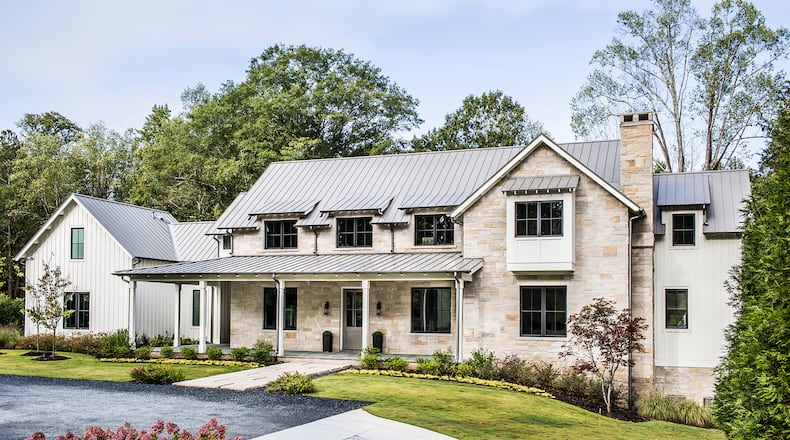Interior designer Tara Fust is challenging one of the most sacred design trends of the day: modern farmhouse.
“Ready for a little truth?” the owner of Roswell-based Tara Fust Design said in her Aug. 28 newsletter. “The modern farmhouse vibe that has infiltrated our feeds, our eyeballs, the aisles at Target is done. Finito. No Mas.”
What is modern farmhouse, and why does it generate this level of antagonism?
If you’ve watched the Chip and Joanna Gaines design juggernaut “Fixer Upper” or caught Shea McGee’s “Dream Home Makeover,” you are probably familiar with this 21st century spin on the classic white-frame farmhouse.
The style takes that symbol of rural American life and runs with it. Modern farmhouse nods to retro Americana but with a modern twist that pairs clean, white minimalism with rustic touches.
On the inside, modern farmhouse is all about:
- A neutral color palette.
- White shiplap paneling, or long wood planks placed horizontally on walls and painted white.
- Exposed ceiling beams.
- Sliding barn doors.
- Live-edge, open wood shelves in which the natural, unfinished side of the wood plank shows.
- Apron sinks, which are low and deep with the front of the sink exposed.
On the outside, you can recognize modern farmhouse by its vaguely “American Gothic” look with a peaked roofline, white paint, black window frames, a homey front porch and board and batten vertical siding, which is a rustic-style siding with thin strips of wood molding placed over the seams of panel boards.
Credit: David Cannon Photography
Credit: David Cannon Photography
For years now, modern farmhouse is the look you’ve seen on the shelves of Target — where both the Gaines’ Magnolia and McGee’s Studio McGee brands are featured — as well as in design magazines and in new developments like Atlanta’s Farmhouses at Ormewood Park.
In the spring, wallpaper company Hovia declared modern farmhouse the most popular interior design style in the country. Or as this New York Times headline pronounced in July: “The Modern Farmhouse Is Today’s McMansion. And It’s Here to Stay.”
But the ubiquity of the style has also prompted a backlash. There is a rising swell of haters, including a private Facebook group with more than 166,000 members called The People Against Modern Farmhouse.
Fust is not alone in her frustration at how modern farmhouse has kept homeowners from expressing their own style.
“A lot of what is being shown to people, as it relates to home design, is looking exceptionally similar,” Fust said. “In my opinion, from our social media feeds to store catalogs and the furnishings that are readily available, we’re not seeing much variation, individuality or a way to curate a home so that it actually reflects the people who live there.”
Credit: Jeff Herr
Credit: Jeff Herr
For many design insiders, farmhouse isn’t so much despised or dead as it is merging with other design styles for a more sophisticated look.
Bulent Baydar, an architect with Harrison Design in Atlanta, notes that his company’s business is about 25 percent farmhouse and modern farmhouse design requests, compared with 50 percent in previous years.
“There is still demand but not nearly at the level of two or three years ago,” Baydar said. “The farmhouse aesthetic is still popular but evolving with the use of warmer colors and materials, such as wood, brick and stone, and wood shake or tile roofs instead of gray metal.”
Karen Ferguson, an interior designer with Harrison Design, noted that “some of the traditional design elements, such as farmhouse sinks, wood countertops and neutral color palettes, will never go out of style.”
Design experts like Baydar, Fust and Ferguson are witnessing a shift to more color and a more global influence.
“We’re seeing growing interest in a more transitional or modern interpretation of English and French Country and Dutch Colonial styles. There are people who desire the simplicity of the modern American farmhouse as well, but with more warm color and material blends,” Baydar said.
Credit: David Cannon Photography
Credit: David Cannon Photography
Fust said she loved the “implied simplicity of farmhouse style. But I also like to see that spirit extended beyond the American farmhouse. I’m a huge fan of a European farmhouse, and the many variations and styles that are able to be incorporated under that umbrella. It’s not unusual to see a really old farmhouse with a very contemporary interior…. It’s that contrast that creates a really interesting result.”
And because the exterior of a home is so fixed while interior design can shift and evolve, Ferguson recommends not locking yourself into the modern farmhouse style outside.
“I would think twice,” she said, “before painting a house ‘appliance white’ with pitch-black windows.”
Felicia Feaster is a longtime lifestyle and design editor who spent 11 years covering gardening, interior design, trends and wellness for HGTV.com. Felicia is a contributor to MarthaStewart.com and has been interviewed as a design expert by The New York Times, Forbes and the Associated Press.
About the Author
Keep Reading
The Latest
Featured





